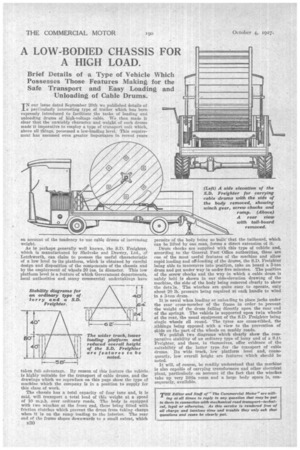A LOW-BODIED CHASSIS FOR A .HIGH LOAD.
Page 48

If you've noticed an error in this article please click here to report it so we can fix it.
Brief Details of a Type of Vehicle Which Possesses Those Features Making for the Safe Transport and Easy Loading and Unloading of Cable Drums.
IN our issue dated September 20th we published details of a particularly interesting type of trailer which has been expressly introduced to facilitate the tasks of loading and unloading drums of high-voltage Cable. We then made it clear that the unwieldy character and weight of such drums made it imperative to employ a type of transport unit which, above all things, possessed a low-loading level. This requirement has assumed even greater importance in recent years
on account of the tendency to use cable drums of increasing weight.
As is perhaps generally well known, the S.D. Freighter, which is manufactured by Shelvoke and Drewry, Ltd., of Letchworth, can claim to possess the useful characteristic of a low level to its platform, which is obtained by careful design and disposition of the components of the chassis and by the employment of wheels 20 ins. in diameter. This law platform level is a feature of which Government departments, local authorities and many commercial undertakings have taken full advantage. By reason of this feature the vehicle is highly suitable for the transport of cable drums, and the drawings which we reproduce on this page show the type of machine which the company is in a position to supply for this class of work.
The chassis has a total capacity of four tons and, it is said, will transport a total load of this weight at a speed of 10 m.p.h. over ordinary reads. The body is equipped with two Winches at the front end, these being fitted with friction clutches which prevent the drum from taking charge when it is on the ramp leading to the interior. The rear end of the frame slopes downwards to a small extent, which
B30 permits of the body being so built that the tailboard, which can be lifted by one man, forms a direct extension of it.
Drum chocks are supplied with this type of vehicle and, according to the General Post Office authorities, these are c.ne of the most useful features of the machine and allow rapid loading and off-loading of the drums, the S.D. Freighter being able to mancouvre into position, take on board a 3-ton drum and get under way in under five minutes. The position of the screw chocks and the way in which a cable drum is safely held is shown in our side-elevation drawing of the machine, the side of the body being removed clearly to show the details.. The winches are quite easy to operate, only about 20 lb. pressure being required at each handle to wind in a 3-ton drum.
It is usual when loading or unloadingto place itteltS under the rear cross-member of the frame in order to prevent the weight of the drum falling directly upon the rear end of the springs. The vehicle is supported upon twin wheels at the rear, the usual equipment of the S.D. Freighter being single wheels all round. The tyres are cross-ribbed, the ribbings being opposed with a view to the prevention of skids on the part of the wheels on muddy roads.
We publish two diagrams which clearly show the comparative stability of an ordinary type of lorry and of a S.D. Freighter, and these, in themselves, offer evidence of the suitability of the latter type for the transport of cable drums. Its wide track, low platform level and, consequently, low overall height are features which should be noted.
It will, of course, be readily understood that the machine is also capable of carrying transformers and other electrical plant, particularly on account of the fact that the winches take sip very little room and a large body space is, consequently, available,




































































































